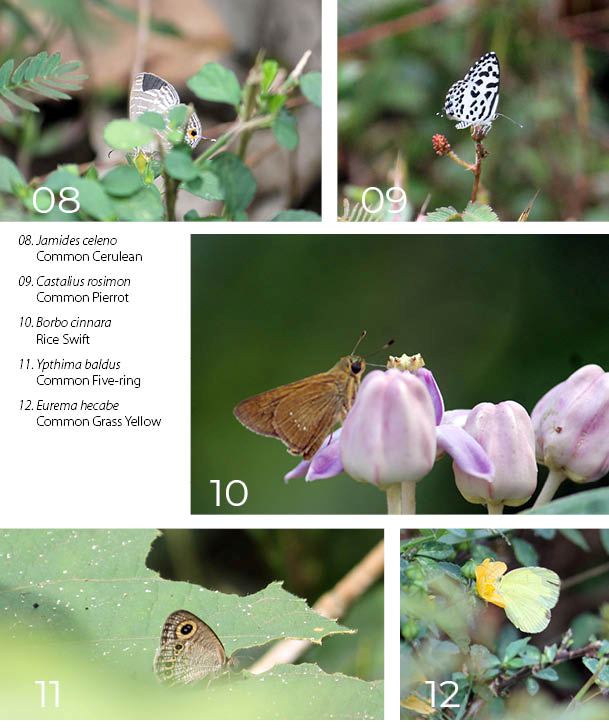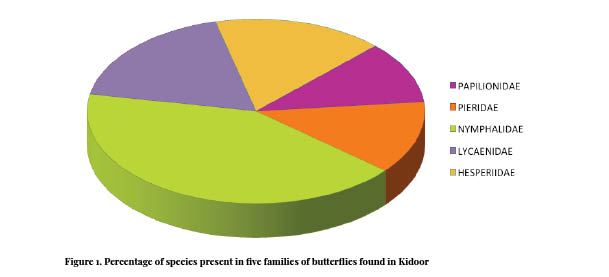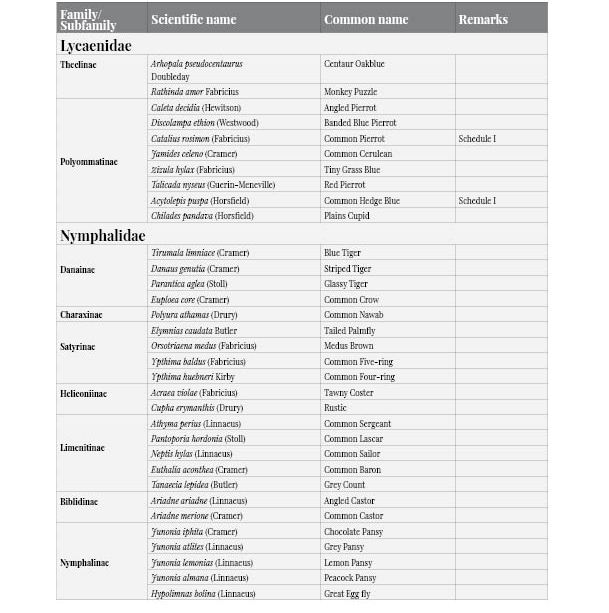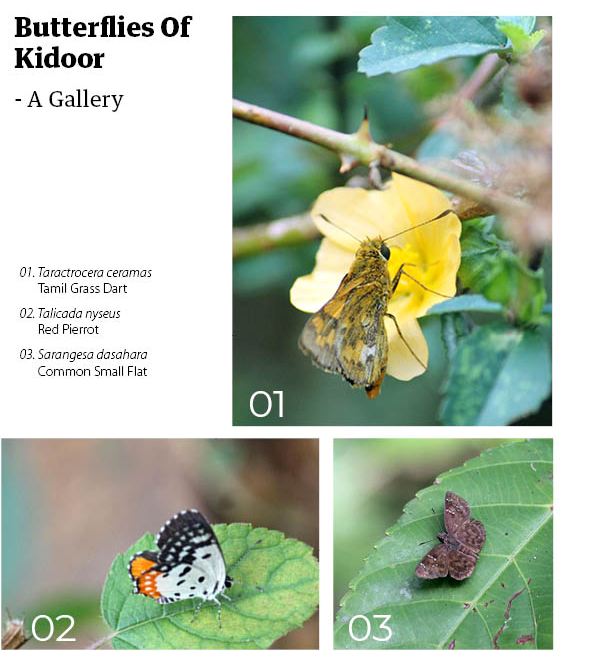Introduction
Butterflies are sensitive biota, which get severely affected by environmental variations and changes in forest structure (Pollard, 1991). They form an important part of the food chain of birds, reptiles, amphibians, spiders and predatory insects. They also respond to disturbances in the quality of habitat, and are thus a good indicator species to evaluate changes in habitat and landscape structure variations (Kremen, 1992; Kocher & Williams, 2000). Butterflies and their caterpillars being dependent on specific host plants for food, their diversity indirectly reflects overall plant diversity, especially that of shrubs and herbs in a given area. Most of them are strictly seasonal and prefer only particular set of habitats (Kunte, 1997).
India has around 1,501 species of butterflies, out of which 334 species are reported from the Western Ghats and 37 species are endemic to the Western Ghats (Evans, 1932; Kunte, 2000). Of the 334 species of butterflies in the Western Ghats, 316 species have been reported from Kerala (Palot et al., 2012).
Very little documentation has been done on butterfly fauna in Kerala. Mathew & Rahamathulla (1993) had reported 100 species of butterflies from Silent Valley National Park, Sudheendrakumar et al. (2000) documented 124 species of butterflies from Parambikulam Wildlife Sanctuary, Arun (2003) found 75 species from Siruvani Reserved Forests, Ambrose & Raj (2005) recorded 24 species from Kalakkad-Mundanthurai Tiger reserve, Eswaran & Pramod (2005) reported 75 species from Anaikatty near Coimbatore, Prasad et al. (2010) recorded 52 species from Kerala University campus, Thiruvananthapuram, and Toms et al. (2010) reported 109 species from Mahatma Gandhi University campus, Kottayam. In the present study, an attempt has been made to document the richness of butterflies in Kidoor surroundings and the findings are presented in this paper.

Study area
Kidoor is a village located at (12.63° N, 74.98° E) in Ward number 7 and 8 in Kumbla Grama Panchayath, Kasaragod district in north Kerala. Kidoor mainly consists of vast lateritic midlands which is one of the major physiographic divisions of the district along with patches of forest and wetlands (Paddy fields). The lateritic area here has many natural ponds, which act as good aquifer by storing large amount of water which in turn is the major source of ground water.

Materials and Methods
The field survey was carried out in the different landscape elements of the study area. Data of butterfly fauna was collected by conducting survey by all out search method from 09:00–17:00 hrs on 20th November 2018. The butterflies were photographed for subsequent identification.
Results
A total of 55 species belonging to 26 genera and 14 subfamilies under 5 families was reported from study area (Table 1). Nymphalidae with 23 species (42%) was the dominant family followed by Lycaenidae 10 species (18%), Hesperiidae 9 species (16%), Pieridae 7 species (13%) and Papilionidae 6 species (11%) (Fig. 1).



Acknowledgements
I am grateful to Raju Kidoor and Maxim Rodriguez for conducting the one-day Butterfly Survey at Kidoor. Sincere thanks to Andrews and Maria, a couple from Germany who also joined during the survey. I would also like to extend my gratitude to Pundarikaksha K L, Kumbla Grama Panchayath President, Krishnan K, District Co-ordinator, Kerala Biodiversity Board and Johnson, Rohan Rai, Rakesh Rai, Sampath K, Sreeshanthi who helped us for the survey and also for participating in the survey.
References
- Ambrose, D. P. & D. S. Raj. (2005). Butterflies of Kalakad-Mundanthurai Tiger Reserve, Tamil Nadu. Zoo’s Print Journal, 20(12): 2100–2107; http://dx.doi.org/10.11609/JoTT.ZPJ.1312.2100-7
- Arun, P. R. (2003). Butterflies of Siruvani forests of Western Ghats with notes on their seasonality. Zoo’s Print Journal, 18(2):1003–1006; http://dx.doi.org/10.11609/JoTT.ZPJ.18.2.1003-6
- Eswaran, R. & P. Pramod. (2005). Structure of butterfly community of Anaikatty Hills, Western Ghats. Zoo’s Print Journal, 20(8): 1939–1942; http://dx.doi.org/10.11609/JoTT.ZPJ.1330.1939-42
- Evans, W. H. (1932). The Identification of Indian Butterflies. 2nd Edition. Bombay Natural History Society, Mumbai, India, 464pp+32pl.
- Kocher, S. D. & E. H. Williams. (2000). The diversity and abundance of North American butterflies vary with habitat disturbances and geography. Journal of Biogeography, 27: 785–794.
- Kremen, C. (1992). Assessing the Indicator Properties of Species Assemblages for Natural Areas Monitoring. Ecological Applications, 2: 203–217.
- Kunte, K. (1997). Seasonal patterns in butterfly abundance and species diversity in four tropical habitats in northern Western Ghats. Journal of Biosciences, 22: 593-603.
- Kunte, K. (2000). Butterflies of Peninsular India. Universities Press (Hyderabad) and Indian Academy of Sciences (Bengaluru), 270pp.
- Mathew, G. & V. K. Rahamathulla. (1993). Studies on the butterflies of Silent Valley National Park. Entomon, 18(3): 185–192.
- Naik, D. & M. S. Mustak. (2016). A checklist of butterflies of Dakshina Kannada District, Karnataka, India. Journal of Threatened Taxa, 8(12): 9491–9504; http://dx.doi.org/10.11609/jott.3066.8.12.9491-9504
- Palot, M. J., V. C. Balakrishnan & S. Kalesh. (2012). An updated checklist of butterflies of Kerala, with their Malayalam names. Malabar Trogon, 9(3): 22–29.
- Pollard, E. (1991). Monitoring butterfly numbers, pp. 87–111. In: Goldsmith, F.B (ed.). Monitoring for Conservation and Ecology. Chapman and Hall, London, 275pp.
- Prasad, G., P. V. Prathibakumari & A. M. Lizby. (2010). Butterflies of Kerala University Campus, Thiruvananthapuram, Kerala. 3rd Asian Lepidoptera Conservation Symposium and Training Programme, 25–29 October 2010, Coimbatore, India.
- S. Aneesh, K & C. K., Adarsh & P. O. Nameer. (2013). Butterflies of Kerala Agricultural University (KAU) campus, Thrissur, Kerala, India. Journal of Threatened Taxa, 5: 4422–4440. Doi:10.11609/JoTT.o2870.4422-40.
- Sudheendrakumar, V. V., C. F. Binoy, P. V. Suresh & G. Mathew. (2000). Habitat association of butterflies in the Parambikulam Wildlife Sanctuary, Kerala, India. Journal of the Bombay Natural History Society, 97(2): 193–201.
- Toms, A., Narayanan, S. P., Babu, V. A., Padmakumar, B., Arun, B., Jaisen, N. D., Paul, J., Deepa, M., Jisha, K., Jayasooryan, K. K., Ranjini, J., Rathy, C.,Sreejith, P. N., Christopher, G. & Thomas, A. P. (2010). Butterfly fauna of the Mahatma Gandhi University campus, Kerala and the strategies adopted for its conservation. Abstract volume of 3rd Asian Lepidoptera Conservation Symposium and Training Programme, 25–29 October 2010, Coimbatore, India, 22-23 pp.
